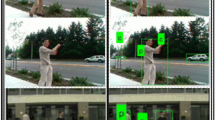Abstract
Vision-based human action and motion recognition system are very demanding assignments for many computer processor request comprises criminal investigations, public video surveillance system, and applications of sports. For lengthy videos capture, it is very hard to identify within a video frame for a particular human action. This paper presents an efficient technique to human action detection, feature extraction, and recognition. In the first phase, in order to identify the moving object, the cumulative difference scheme is applied. The next phase, in aim feature tracking based on the proposed cumulative difference energy representation (CDER) technique is used. In our proposed research, we have evaluated different machine learning techniques methods, namely K-nearest neighbors, support vector machine, random forest, naïve Bayes, and decision tree. Experimental results were conducted on the publically available human action KTH datasets considering six activities, viz. (hand clapping, walking, hand waving boxing jogging, and running). The research results express that proposed CDER technique outperforms the majority of previous schemes, accomplishing accuracy of 98.67% for SVM classifier.
Access this chapter
Tax calculation will be finalised at checkout
Purchases are for personal use only
Similar content being viewed by others
References
Aggarwal, J., Cai, Q., 1997. Human motion analysis: A review. In: Proc. Nonrigid and Articulated Motion Workshop. IEEE, pp. 90–102.
Aggarwal, J., Ryoo, M., 2011. Human activity analysis: A review. ACM Comput. Surv., 0360–0300 43, 16:1–16:43. http://dx.doi.org/https://doi.org/10.1145/1922649.1922653
Ray, K. S. & Chakraborty, S. (2017a). An efficient approach for object detection and tracking of objects in a video with variable background, arXiv preprint [Online]. Available at: <http://arxiv.org/ abs/1706.02672>.
Ahad MAR, Tan JK, Kim H, Ishikawa S (2009) Temporal motion recognition and segmentation approach. Int J Imaging Syst Technol 19(2):91–99
Dalal N, Triggs B (2005) Histograms of oriented gradients for human detection. In: IEEE computer society conference on computer vision and pattern recognition, 2005. CVPR 2005. IEEE, vol 1, pp 886–893.
Mikolajczyk K, Schmid C (2005) A performance evaluation of local descriptors. IEEE Trans Pattern Anal Mach Intell 27(10):1615–1630
Abdelbaky A, Aly S (2020) Human action recognition using short-time motion energy template images and PCANet features. Neural Comput Appl. Springer Nature. https://doi.org/10.1007/s00521-020-04712-1
Elharrouss O, Almaadeed N, Al-Maadeed S, Bouridane A, Beghdadi A (2020) A combined multiple action recognition and summarization for surveillance video sequences. Appl Intell. https://doi.org/10.1007/s10489-020-01823-z
Cao S, Wang X, Xiang K (2017) Visual object tracking based on Motion-Adaptive Particle Filter under complex dynamics. EURASIP J Image Video Process 2017(1):1–21. https://doi.org/10.1186/s13640-017-0223-0
Zhao H, Xiang K, Cao S, Wang X (2016) Robust visual tracking via CAMShift and structural local sparse appearance model. J Vis Commun Image Represent 34:176–186. https://doi.org/10.1016/j.jvcir.2015.11.008
Thabet E, Khalid F, Sulaiman PS, Yaakob R (2021) Algorithm of local features fusion and modified covariance-matrix technique for hand motion position estimation and hand gesture trajectory tracking approach. Multimedia Tools Appl 80(4):5287–5318. https://doi.org/10.1007/s11042-020-09903-5
Nallasivam M, Senniappan V (2021) Moving Human Target Detection and Tracking in Video Frames. Studies in Informatics and Control 30(1):119–129
Sultana M, Mahmood A, Jung SK (2020) Unsupervised moving object detection in complex scenes using adversarial regularizations. IEEE Trans Multimedia. https://doi.org/10.1109/TMM.2020.3006419
Sargano AB, Angelov P, Habib Z (2017) A comprehensive review on handcrafted and learning-based action representation approaches for human activity recognition. Appl Sci 7(1):110
Laptev I, Caputo B (2011) Recognition of human actions
Sathya R, Kalaiselvi Geetha M (2013) Vision based traffic police hand signal recognition in surveillance video—a survey. Int J Comput Appl (IJCA) 81(9):1–10
Breiman L (2001) Random forests. Mach Learn 45:5–32
Farid DM, Rahman MZ, Rahman CM (2011) Adaptive intrusion detection based on boosting and nave Bayesian classifier. Int J Comput Appl 24:12–19
Quinlan JR (1986) Introduction of decision trees. Mach Learn 1:81–106
Moussa MM, Hamayed E, Fayek MB, El Nemr HA (2015) An enhanced method for human action recognition. J Adv Res 6:163–169
Jin C-B, Li S, Kim H (2017) Real-time action detection in video surveillance using sub-action descriptor with multi-CNN. arXiv:1710.03383
Yang J, Ma Z, Xie M (2015) Action recognition based on multiscale oriented neighborhood features. Int J Sig Process Image Process Pattern Recognition 8(1):241–254
El-Henawy I, Ahmed K, Mahmoud H (2018) Action recognition using fast HOG3D of integral videos and Smith-Waterman partial matching. IET Image Process 12(6):896–908
Liu H et al (2017) Study of human action recognition based on improved spatio-temporal features. In: Human motion sensing and recognition. Springer, pp 233–250
Kaminski Ł, Mackowiak S, Domanski M (2017) Human activity recognition using standard descriptors of MPEG CDVS. In: 2017 IEEE international conference on multimedia & Expo Workshops (ICMEW). IEEE
Dasari R, Chen CW (2018) MPEG CDVS feature trajectories for action recognition in videos. In: 2018 IEEE conference on multimedia information processing and retrieval (MIPR). IEEE
Author information
Authors and Affiliations
Corresponding author
Editor information
Editors and Affiliations
Rights and permissions
Copyright information
© 2023 The Author(s), under exclusive license to Springer Nature Singapore Pte Ltd.
About this paper
Cite this paper
Sathya, R., Gokulakannan, E. (2023). Computer Vision Human Activity Recognition Using Cumulative Difference Energy Representation-Based Features and Employing Machine Learning Techniques. In: Asari, V.K., Singh, V., Rajasekaran, R., Patel, R.B. (eds) Computational Methods and Data Engineering. Lecture Notes on Data Engineering and Communications Technologies, vol 139. Springer, Singapore. https://doi.org/10.1007/978-981-19-3015-7_40
Download citation
DOI: https://doi.org/10.1007/978-981-19-3015-7_40
Published:
Publisher Name: Springer, Singapore
Print ISBN: 978-981-19-3014-0
Online ISBN: 978-981-19-3015-7
eBook Packages: Intelligent Technologies and RoboticsIntelligent Technologies and Robotics (R0)




